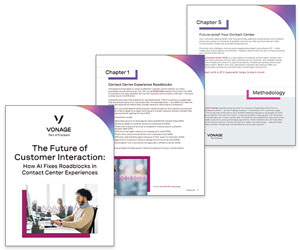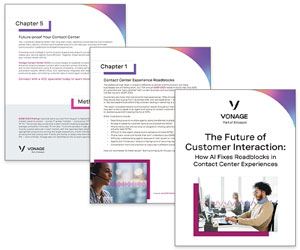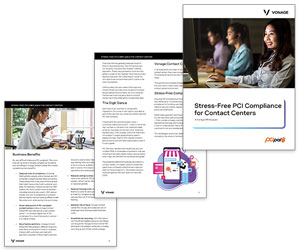Martin Hill-Wilson sets out a list of short-term predictions for the ambitious players within the contact centre industry.
At the start of the year, I took part in a webinar with Call Centre Helper’s Editor Jonty Pearce and NewVoiceMedia’s RVP Services EMEA Phil Davitt and we shared views on this year’s industry predictions.
Jonty pointed out that the annual webinar, which this post is based on, has a pretty good track record. Nine out of the ten topics mentioned in our inaugural 2014 version have become mainstream.
So, here’s hoping that form still runs true for this latest iteration, from which nine are discussed below.
1. AI & Contact Centres
While all the featured trends are important, a few have the power to pivot our whole industry. AI is one of them. We are now beyond the bot conversation stage and are starting to appreciate that AI technologies such as natural language understanding and machine learning will turbo-boost everything from routing to recruitment.
The net impact will be a significant shift from reactive to proactive responsiveness. From working harder to working smarter.
2. Omnichannel Design
Brands still struggle with the reality that omnichannel is about customer choice not cost reduction. Too many digital agendas still focus on deflection rather than meeting five generations of customer expectation around live assistance, self-service and being proactive.
On top of that, new channels also continue to arrive, especially of the messaging type such as RCS and Apple Chat, reflecting generational adoption of asynchronous interaction. The only way to avoid this increasing complexity and cost is to develop a set of strategic design principles based on in-depth behavioural insight of your customer needs.
3. A Unified Ecosystem
Zooming out from just the issue around channel orchestration is the broader challenge of knitting together journeys, workflow and data, all of which are typically housed in siloed systems. Regardless of how this is technically enabled, having the vision and insistence on achieving effective integration that supports low-effort, personalised customer outcomes increasingly matters.
Two practical examples to focus on this year: the first is desktop simplification, for those still to tackle this, so that advisors can focus on customer experience. The other is the interchange between live and virtual assistance. In particular, making sure that customer context and intent follow wherever the conversation goes.
4. Technology-Enabled Innovation
We have come a long way since contact centre infrastructure was housed in proprietary hardware and software. Open standards, cloud functionality, programmable microservices and APIs, combined with AI smarts, now offer the budding Lego builder entirely new possibilities.
We are on the cusp of a whole new chapter in the ‘art of the possible’. In addition to the standard set of customer engagement frameworks the industry is accustomed to choosing from, expect to see service-design-led innovations from disruptive vendors and ambitious in-house teams. For instance, what about inventing a non-IVR way of connecting customers to the best resource?
5. New Teamwork Now Needed
DevOps is all the rage within technology tribes. That’s because it’s the latest iteration in the evolution of how technology-powered solutions are designed, tested and launched. From waterfall to agile and beyond, the common thread is to create tightly coordinated teamwork that operates in short, feedback-led bursts. The goal is to stay relevant to evolving customer needs and deliver quality outcomes on time.
This is how the opportunity for innovation mentioned in the previous prediction is best delivered. Some brands have even gone as far as embedding this methodology and mindset into customer service teams as well, de-risking the path from conception to live delivery.
6. Expanding the Talent Pool
It’s never been easy to find talent in competitive markets. Contact centres are a case in point. In terms of predictions, here are some familiar and not so familiar themes. We know cloud contact centres enable both virtual and home-based resource models. As more centres migrate to the cloud, more can consider these options.
Maybe newer is the notion of tapping into those of us who make up the gig economy and enjoy that lifestyle. In response, there are now smart platforms in play that support everything from onboarding, skilling, performance management and remuneration to help introduce this new source of talent to contact centres.
7. Inspiring the Best From People
With such an obsession for cost control, it’s no surprise that contact centres have relied on command and control behaviour. While this ticks the boxes on an efficiency agenda, it fails miserably against any people agenda such as engagement, innovation, happiness or advocacy.
Even WFO, the main tool for squeezing the last pip from frontline teams, has now morphed into WEM – workforce engagement management. This manifests as anything from self-service-enabled shift swapping to an entire cultural shift that incorporates personalised pathways for micro-learning and behavioural economics for nudging motivation.
8. Aligning Quality Management With Customer Experience
Traditional QA draws its point of reference from an internal view of what matters. In many cases this translates into regulatory conformance and a prescriptive view of what customers need. To cap it all, the sample sizes that are feasible to collect manually leave service leaders exposed to what they remain blind to.
Thankfully, a new generation of thinking is changing things. Meeting the expected standard (one way to define quality) is based on fulfilling the functional and emotional needs of individual customers in individual service journeys. It’s the outside-in view that counts. In this context, the quality and CX agendas start to align. Additionally, quality insights need to scale, which is why the introduction of interaction analytics makes such a transformational impact. Now it’s affordable, it’s time to embed it.
9. Aligning Contact Centre Outcomes With Strategic Customer Experience Aims
The final prediction for 2019 is that contact centres will start to embrace emotion management as a leadership discipline. In an age of increasing automation, leveraging the human touch effectively will define the success of brand engagement.
Negative emotional outcomes drive us away from brands. Positive ones build goodwill. This is the foundation for delivering CX benefits which, put simply, results in more profitable customers over time. Contact centres influence this during each and every interaction.
In Conclusion

Martin Hill-Wilson
So that’s it. For the numerically alert, you will have noticed only nine predictions were offered. The tenth was simply an acknowledgement that some teams will have such a full agenda of their own making that none of the ones mentioned here make it onto their 2019 action plan.
Regardless of what you are focused on, I wish you every success in advancing your strategic agendas.
Author: Robyn Coppell
Published On: 25th Apr 2019 - Last modified: 18th Mar 2024
Read more about - Guest Blogs, Martin Hill-Wilson, Vonage



















